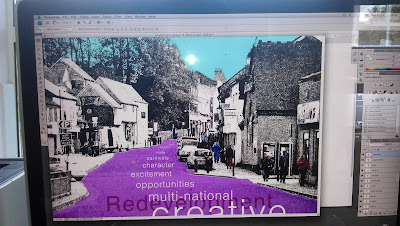This is the first attempt of my poster. I have made a stencil for the brickwork and then printed paint using a very course sponge through the stencil. The colours are reflective of the graffiti down London's Brick Lane. The piece is only in its early stages, but it is bright and colourful and conveys this new creative artistic Far Gosford Street in the way that they want it to be portrayed. At the moment however, it is unsophisticated. The Far Gosford Street sign is just an overlay in Photoshop and I do not like the angle that it makes on the brickwork. I am going to try completing the poster horizontally and on larger paper so that the brickwork is smaller and more intricate.
This is the construction process of the developed poster. The stencil has been laboriously cut out by hand so that it has a handmade miss-match brickwork feel to it. This reflects both the creative aspect of the street and also the medieval construction of some of the houses down the street. Brickwork and woodwork is not constructed with even horizontal patterns, similar to my brickwork stencil.
This is the developed poster. I actually really liked the stencil that I printed through as well as the print itself, so I have encorporated this in the design. I have displaced the stencil slightly on the print so that you get a white outline on some of the sides of the brick, giving the poster a 3 dimensional feel. I actually think that this effect is quite effective. However, it is becoming confusing to understand. The colours are a lot better in this piece- they are bright and bold and vibrant, but there is more brickwork so the piece looks more sophisticated and considered in design. One of the issues that I have with this piece is the Far Gosford Street sign. I like its placement and what it is trying to suggest- its the origional street sign for the street and so conveys the rich history of the street against the vibrant and colour future, however it is still just a digital edited overlay and so does not work. I think I am approaching a final solution to this poster, but there is some things that I need to consider in the final production:
- The posters that I hand over I want to be origional pieces of artwork rather than digital printouts as the origional artwork has such a better, more tactile and textured quality. Therefore I will not be handing over any digital copies to the client, only copies that are produced by hand. Therefore, every poster I hand over will be unique in some way as I will not be able to, or want to colour match the posters every time I print through the stencil.
- The Far Gosford street sign I need to produce by hand so that it works with the rest of the poster and has an overall handmade quality. Therefore I will screenprint this sign onto the final designs.
- Some of the posters I produce will have different hues to them. This is so that they will have a poster that will suite a number of different environments (this way the posters are more likely to be displayed more frequently), whilst maintaining the colour scheme of the London Brick Lane artwork.
This is the production of my final posters for this idea. The Far Gosford Street sign has been screen printed. I really like the way that this has come out, I think it is effective against the brickwork. It has a really nice textured look to it that compliments the heavy texture of the coloured bricks. I have produced 7 of the posters, each are individual. 6 of these have now been handed over to the client, I have retained one. I hope to take photos of the places that these posters have been displayed to contextualize the work.












































